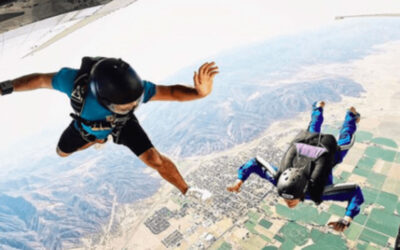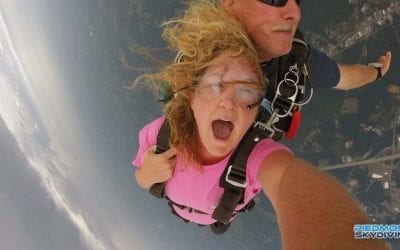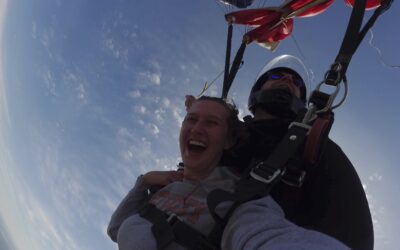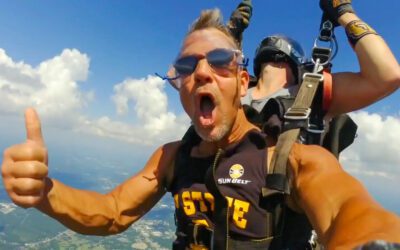The first time you do anything can be a challenge, especially if you don’t know much about it. If you’ve never been skydiving before, it’s probably safe to say that you’re not an expert… yet.
From selecting the right dropzone to getting the most out of your air time, there’s a lot of information that can help improve your skydiving experience. In this article, we’ve laid out that information from basic principles to specific tips and tricks. It’s our goal to make sure you have the best experience possible. Hopefully, this article will help you do just that!
About Tandem Skydiving
First and foremost, you won’t be in this alone. To skydive for the first time, you must be with a tandem skydiving instructor. That means that you won’t actually be the one doing the work. It’s the job of the tandem instructor to keep you stable in the air, pull the parachute at the right altitude, and steer you back for a soft and safe landing.
If you’re looking to level-up and skydive solo, you’re looking for something called an Accelerated Freefall Program. These programs are designed to get you certified to skydive by yourself. Even these programs, however, must begin with a tandem skydive.
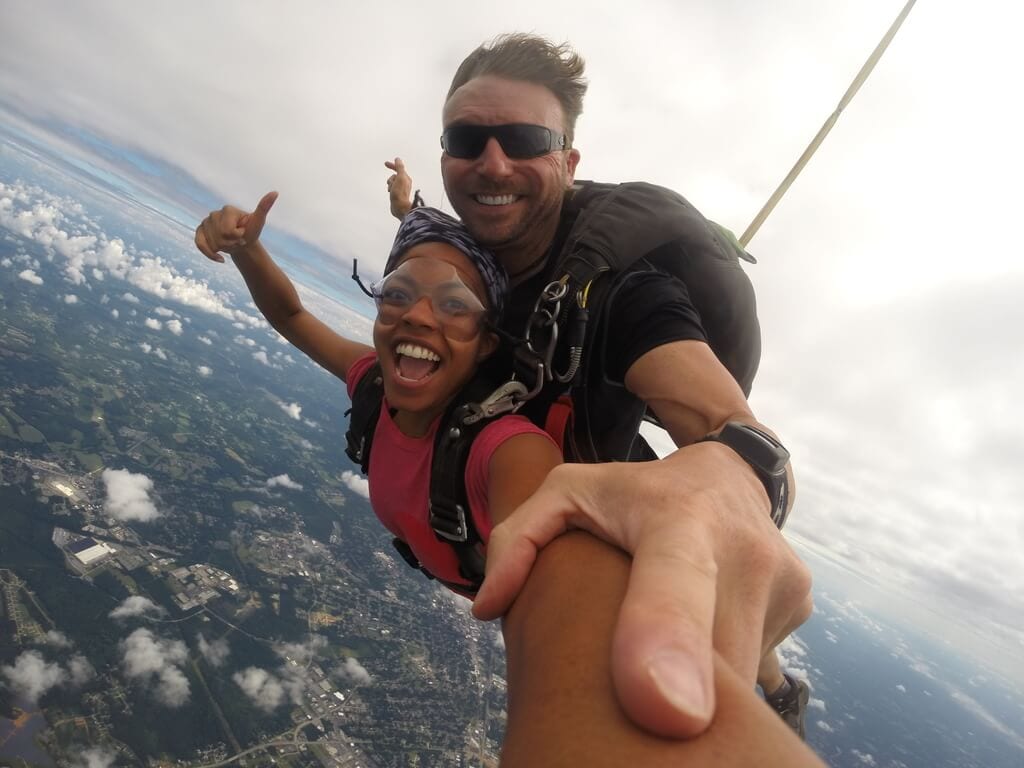
Who Can Go Skydiving?
The first step to a successful skydive is to make sure that you can skydive in the first place! Almost anyone can skydive, but there are a few requirements that exist for the safety of both the skydiver and the instructor. These may vary based on the dropzone, so be sure to double-check after you select one.
Age & Weight Requirements
The USPA requires that any skydiver within US territory must be at least 18 years of age. Most dropzones require a photo ID to prove your age, so make sure to bring one!
There’s only one exception to this rule, and it’s actually pretty sweet. Waivers CAN be granted to terminally ill patients under the age of 18 who want to check skydiving off of their bucket list before they’re unable to do so. The Make a Wish Foundation even offers skydiving as one of their events, with over 100 Skydives taking place since 2011.
Weight limits may also exist for tandem skydivers. Many instructors can fly with a tandem passenger weighing up to 230 lbs. For the safety of both the passenger and the tandem instructor, passengers over 200 lbs. may also be required to be physically fit in order to jump.
Health & Fitness Requirements
Skydiving is the adrenaline-filled adventure of a lifetime. While high-speed fun can sometimes mean health limitations, skydiving is actually not as intimidating as it may seem. Skydiving only takes about as much physical exertion as jogging to your mailbox and back would. That being said, all participants in skydiving must still meet the USPA’s Basic Safety Requirements for medical fitness.
Make sure that you’re in good health and physical condition and not on any medications which could affect your judgment or performance. Also, make sure your instructor knows about any medical conditions that may affect your skydive. People who have recently gone SCUBA diving or donated blood should wait a period of time before skydiving.
Ask a physician If you’re still concerned that you might not be healthy enough to skydive. However, as a general rule of thumb, don’t go skydiving if you’re not 100% confident you’re healthy enough to do so. Better safe than sorry!
Skydiving with physical disabilities
One of the many awesome things about skydiving is that it’s an adventure that doesn’t discriminate. Because of the structure of a tandem skydive, many physical disabilities are either irrelevant or only a minor factor. Just make sure that the dropzone is aware of any physical disabilities that require accommodation before the day of the skydive.
Choosing Where to Skydive
Once you’ve determined that you meet the requirements to skydive, you need to select a dropzone. This is arguably the most important factor in a successful skydiving experience. Here are a few steps to make sure that you choose the right one:
Select a USPA Dropzone
An important factor for any dropzone is a USPA (United States Parachuting Association) membership. The USPA is the governing body for skydiving in the US. A dropzone that isn’t a member of the USPA isn’t required to follow their safety guidelines, which likely means they have more lenient, and therefore dangerous, policies.
Selecting a USPA dropzone will also ensure that the dropzone is, in fact, real. Believe it or not, there are a lot of dropzones that appear to exist online but aren’t real skydiving centers. Your best bet is to select a dropzone from the USPA DZ Locator tool.
Check for consistently high ratings & reviews
One of the best ways to tell how good a certain dropzone is to take a look at their online ratings. Make sure you read both good and bad reviews from any dropzone you’re considering for your first time skydiving. Look for a dropzone with a lot of reviews.
Comments about good instructors, picture/video quality, and overall experience are something to look for as well. Check ratings on dropzones facebook pages, google reviews, and yelp to make sure you get a full picture of how the dropzone is rated.
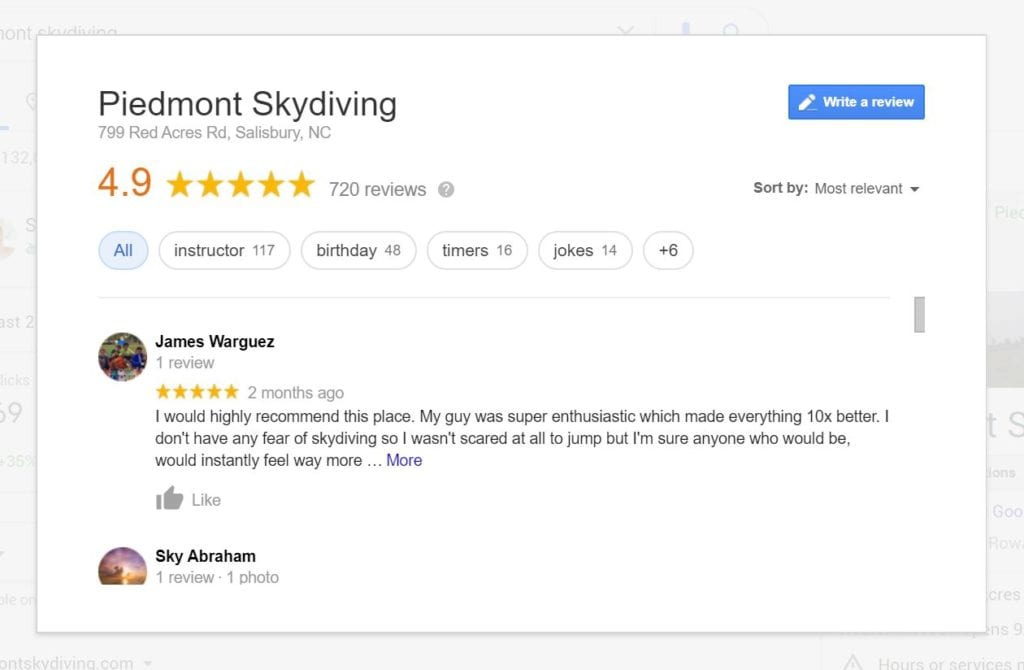
Check the skydiving packages and what they include
Pricing is always important, but it’s important to look at what’s included with that price as well. Check for a good price that includes all gear and safety equipment. Also, look for good photo and video packages that aren’t at astronomical prices. Also, be sure to check for special skydiving deals that may only be available on certain sites.
Find out what skydiving options are offered
Even though a tandem skydive is required for the first time, you still have options for your skydive. You’ll want to check for different types of skydives and photo and video options before you make a decision.
Skydiving Altitudes
A big difference in skydiving experience has to do with the altitude of the jump. The standard altitude for a sport tandem skydive is from 12,500ft (about 2.4 miles) above ground level. This means about 50 seconds of freefall before deploying your parachute. If you’re looking for even more excitement, look for a dropzone that offers a “High Altitude” option. For example, a 17,500ft high altitude skydive can offer up to 80 seconds of adrenaline-filled freefall.
Photo & Video Packages
Different dropzones will have different options for photo & video packages. If capturing the experience is important to you, then make sure you select a dropzone with a good photo and video package at a reasonable price. Check if they have a youtube channel or if skydivers have posted videos from the dropzone. This will give you a good idea of the quality and style of content that they provide.
Once you’ve selected a dropzone, thoroughly look through their website or just give them a quick phone call. Make sure that all of your questions are answered and you know exactly what package you want. Then, book your adventure!
Preparing for Your First Skydive
So you’ve chosen a dropzone and booked a tandem skydive. As the day gets closer, you get more and more excited for your first skydive. Now it’s time to think about preparing for the big day!
Make sure you know how long it’ll take you to get to the dropzone and have your route mapped out. Plan to arrive a few minutes before the scheduled time. It’s important to keep in mind that you’ll likely be at the dropzone for around 2-3 hours. This number, however, could be much longer depending on the weather or other unforeseen factors.
Skydiving attire: what to wear
Tandem skydiving doesn’t require you to purchase any fancy skydiving suit or special gear. Most drop zones will provide you with all of the safety equipment you need for a successful jump. Make sure you wear athletic clothing that’s comfortable and snug. Wear closed-toed shoes that don’t slip off and be sure to remove loose jewelry and accessories.
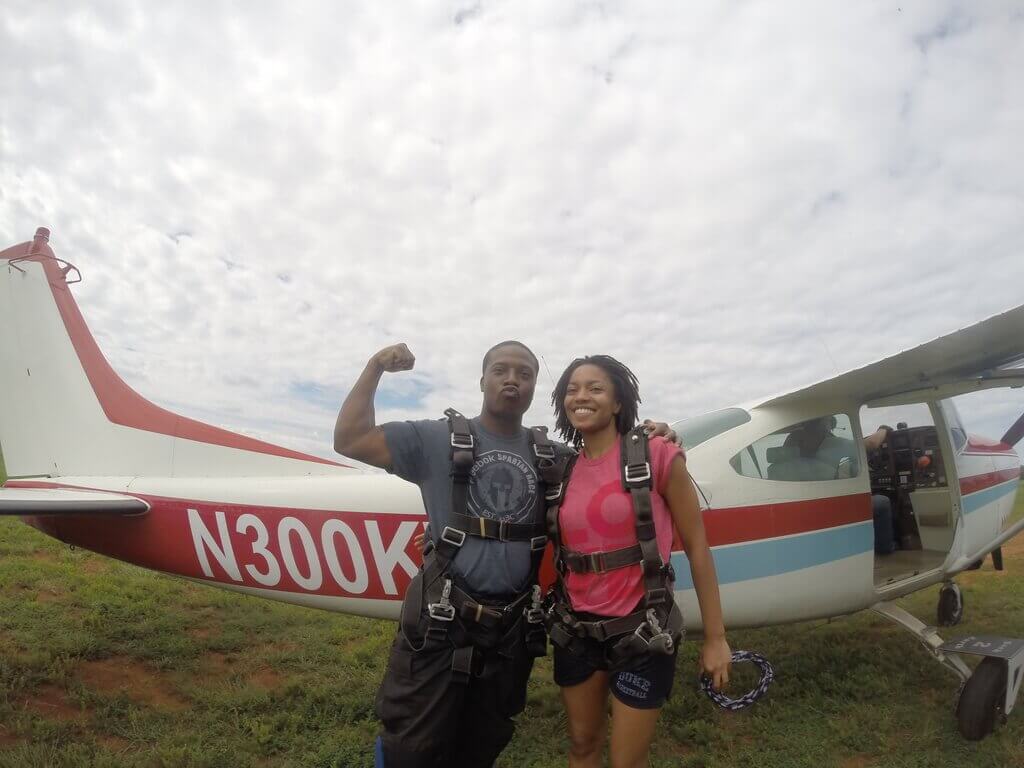
Wearing glasses while skydiving
Most drop zones will have goggles that can be placed over eyewear when skydiving. However, there is still a risk of losing them. If you have contacts or glasses with a smaller frame, opt to wear those instead.
Eating & drinking before a skydive
Make sure that you eat a good meal around 30 min before your scheduled time. Many dropzones have vending machines or snack bars, but double-check before you bank on them having one and don’t bring any snacks of your own. Leave enough time for the food to digest, but not so much time that you’re starving once it’s time to skydive. You don’t want anything to take your focus away from the experience!
It’s also important to make sure that you’re well-hydrated before your first skydive. Use the restroom before you get on the plane. Once you leave the dropzone, it’ll be about 20-25 min until your feet are back on the ground, so plan accordingly!
Alcohol & Skydiving
Drinking alcohol the night before or day of a skydive is a terrible idea, trust us. The FAA and USPA both require a minimum of 8 hours after drinking to skydive but recommend a full 24 hours. On top of that, skydiving hungover can be an easy way to lose your lunch and piss off your instructor.
Many drop zones have strict policies against bringing alcohol onto the premises and attempting to skydive while under the influence. This is for the safety of the skydivers and the instructors. If these rules are broken, it’s likely that the dropzone will not allow you to skydive and will not refund your money.
What to bring (and not to bring!)
When you’re packing up for your skydiving adventure make sure you’re only taking what’s absolutely necessary. Make sure you have a form of payment and a photo ID to prove your age. You can bring your phone to the dropzone, but you likely won’t be able to take it with you on the actual skydive. Many dropzones offer photo & video packages with equipment that they provide, so you won’t have to worry about bringing a camera or gopro to capture the experience.
Friends & Fur Babies
Skydiving is even more fun when you have friends and family along to celebrate with you, so feel free to bring them along! If they’re only there as spectators, as them to come around 35-45 min after your scheduled time. That way, they’ll take a pass on the waiver/payment/instruction/gear-up process, but will be able to catch you coming in for a landing.
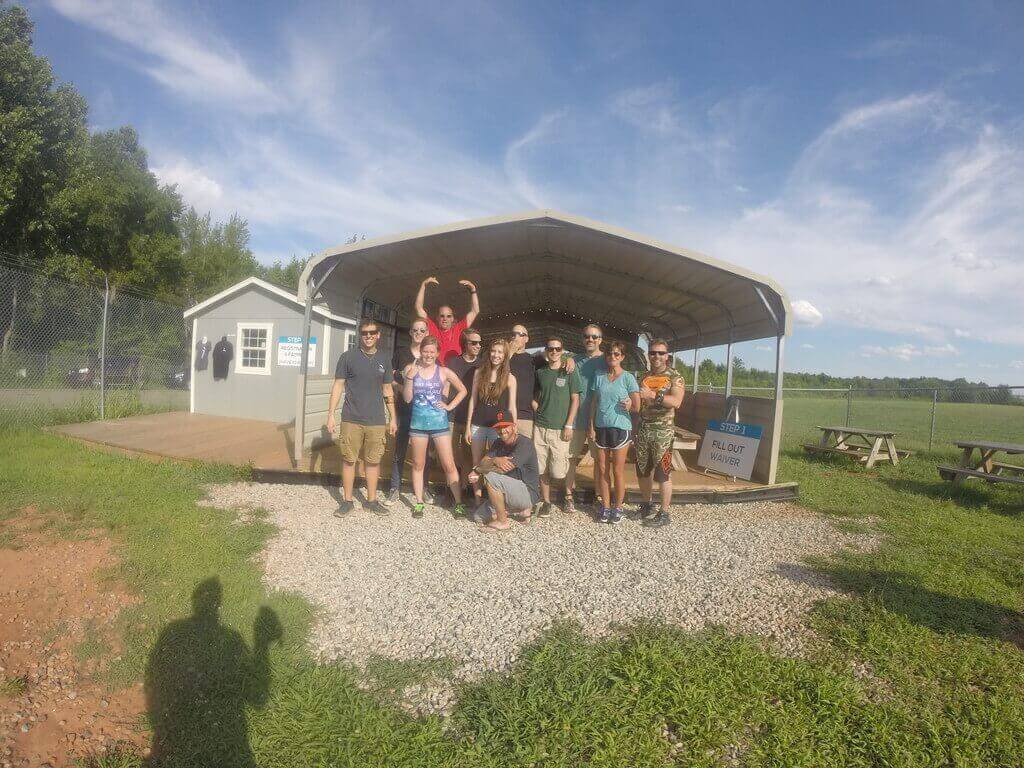
In addition to your human friends, you might want to bring your animal along too. Unfortunately, dogs and dropzones don’t mix. No matter how well-behaved the dog, an active airfield with a skydiving operation isn’t a safe place at all for pups. This may differ from dropzone to dropzone, but as a general rule of thumb, it’s a good idea to leave them at home. But don’t worry, they’ll enjoy the video later!
Before Your Jump
Once you get to the dropzone the excitement really starts to kick in! Policies and procedures upon arrival can vary quite a bit depending on the skydiving center. We’ve based the information in this section on what we do at Piedmont Skydiving, so keep that in mind if your first time skydiving is at another dropzone.
Registration & Liability Release
Once you arrive at the dropzone, you’ll likely begin by filling out a registration form and signing a liability release. Make sure to read these carefully and understand that you’re agreeing to everything in the document.
The purpose of most standard liability releases is to verify that you understand that there are risks involved in skydiving and that you agree to accept those risks. It’ll also likely contain a contract in which you agree to not sue the skydiving center or anyone else if you’re injured. These are standard for most companies that run physical activities.
Meeting your instructor & ground training
For your first time skydiving, you’ll be paired with a tandem skydiving instructor. To become a skydiving instructor you need to be a member of the USPA and log 500 jumps and 3 hours of freefall, MINIMUM. To put that in perspective, the instructors at Piedmont Skydiving have made an average of 5,000 jumps each. That’s 10x more than the minimum!
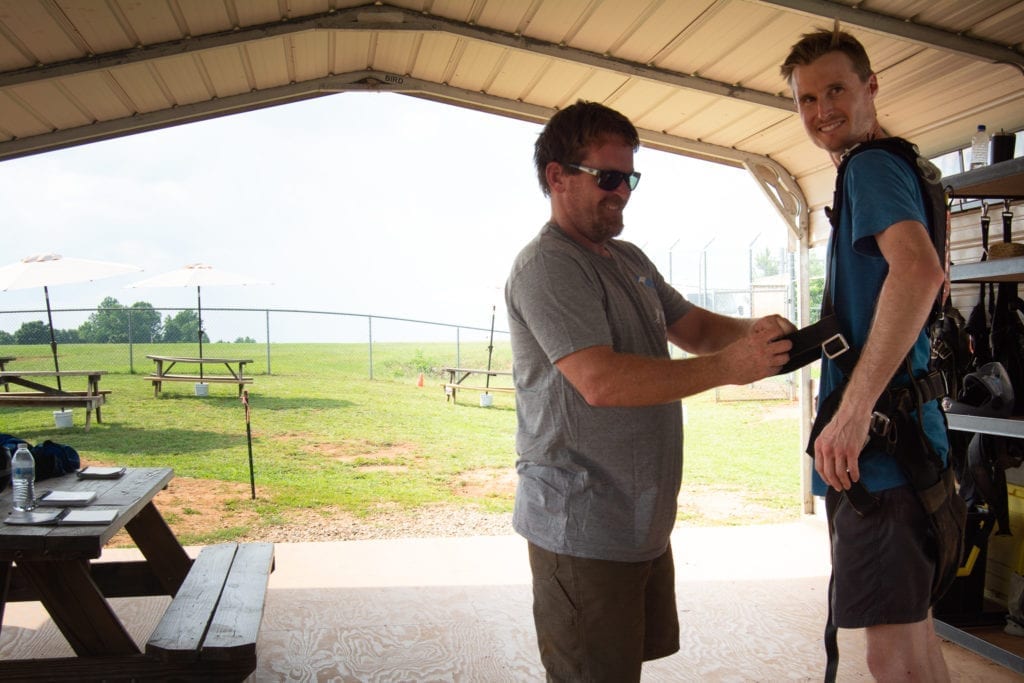
These instructors are incredibly knowledgeable, experienced, and (at least here!) extremely charismatic! They’ll take care of all of the hard work so you can enjoy your skydive. However, you still need to pay close attention to the safety briefing and ground training.
The Skydiving Experience
After you meet your instructor and are all geared-up, it’s time to go! Our staff will make an announcement 5-10min before it’s time to go so that you have time to use the restroom and prepare for your skydive.
When your group is called, your instructor will walk you out to the skydiving aircraft. Your instructor will ask you to sit on one of the benches directly in front of them where they’ll strap your harness onto theirs and get you ready to go.
1, 2, 3… Jump! Exiting the Aircraft
As soon as you get to altitude (about 12,500ft for a normal skydive and about 17,500ft for a high altitude skydive), the pilot will give the “go” signal and one of our staff members will open the door. You’ll feel a cold rush of refreshing air and your instructor will make sure one last time that you’re excited and ready to go. They’ll move with you towards the door, give you a thumbs up, and you’ll jump out together!
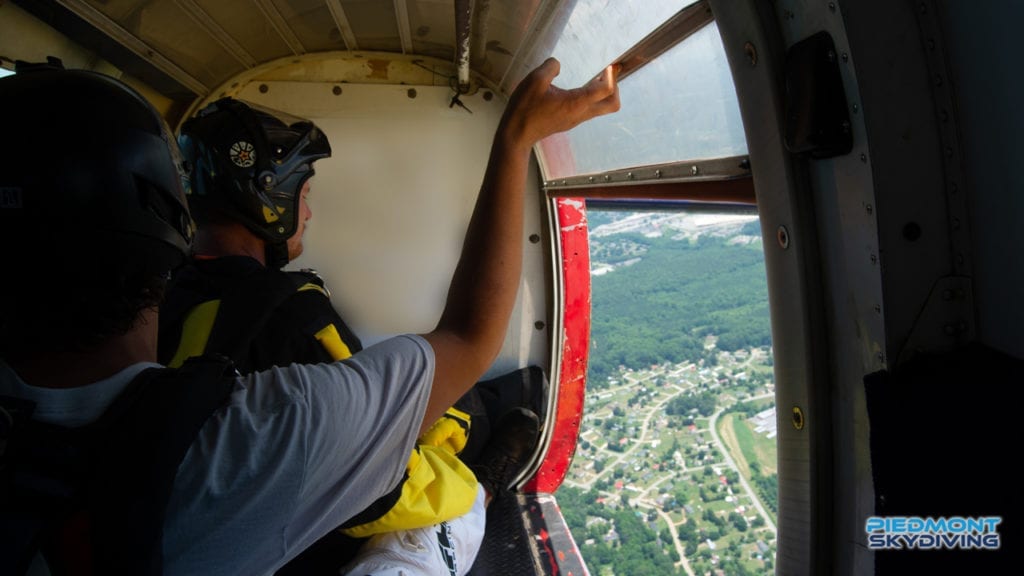
Changing Your Mind
For the record… this almost NEVER happens. Here’s what Andrew Karnowski, the Dropzone Manager at Piedmont Skydiving had to say about it: “Our instructors are really good at making you feel safe, confident, and excited. Once we get up there, if you change your mind, we definitely won’t force you to jump out if you don’t want to. We’ll just take you back down on the plane, no harm no foul. But again… that never happens.”
“I’ve taken almost 6,000 people up, and only 4 or 5 decided not to jump. Once that door opens, even if you’re scared, you’re gonna want to do it. Everyone does, and everyone ends up loving it.”
– Jerry Blanton, Pilot at Piedmont Skydiving
So, even if you’re scared, chances are you’re going to want to jump once you’re in the air. But, even if you DO change your mind, the pilot will just take you back down the long (and much less fun) way!
What it feels like to Freefall
When you jump out of the aircraft you won’t feel that “rollercoaster drop” feeling in your stomach that most people expect. Instead, it’s more like a turbo-jet engine full of adrenaline blowing straight at you as you fall through the sky for 45-80 seconds. And it… is… awesome. Your tandem instructor will take care of all of the hard work, so all you have to do is enjoy the experience.
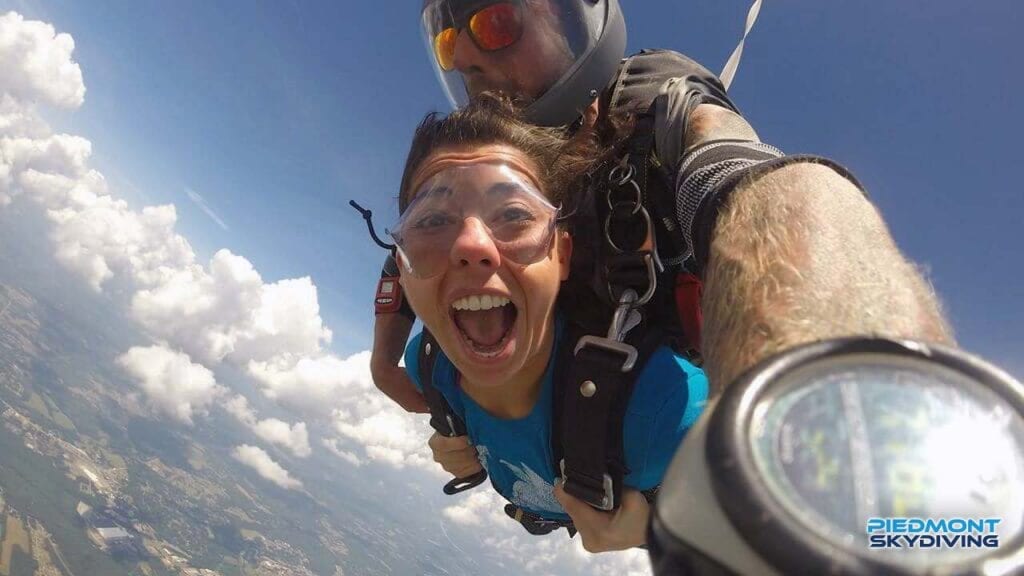
The Parachute Ride
Once you reach the correct altitude, your instructor will pull the parachute to bring you out of freefall. You’ll feel a bit of a jolt, but it’s typically nothing more intense than a quick stop at a stoplight or jumping off of a diving board. Once the chute is open, you’ll get a 4-7min parachute ride back to the dropzone. You can ask your instructor for a calm, scenic ride back or an incredible rollercoaster ride thousands of feet in the air. It’s up to you!
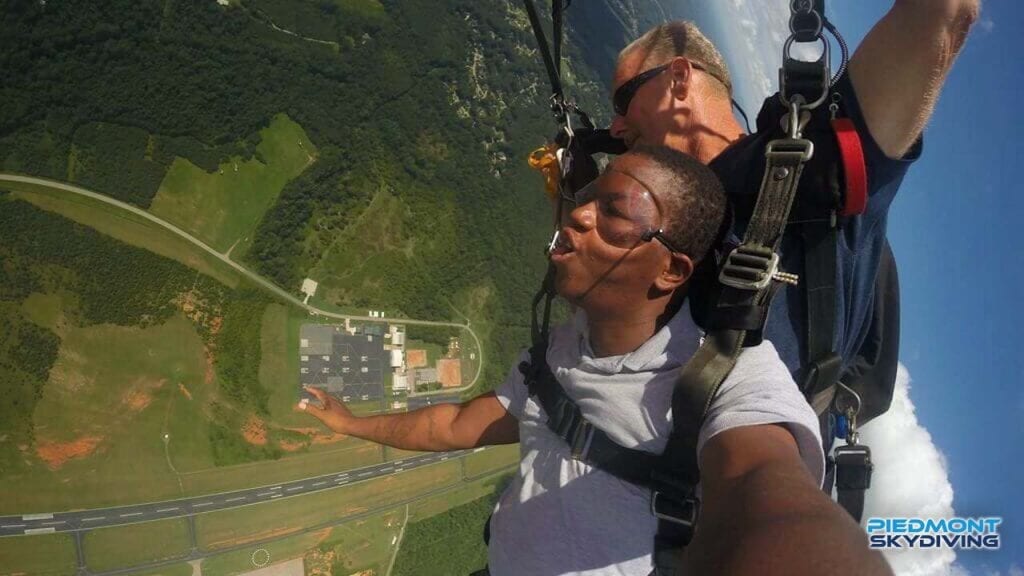
The Landing
Once you’re close to the ground, your instructor will ask you to lift your feet and prepare for landing. Our experienced instructors will land you right back at the dropzone. The landing shouldn’t be much harder than jumping down from a 2-4ft box. You’ll be right next to the spectator area so that any friends and family who came to watch will be able to see you land!
And that’s it! The whole skydiving experience! If you still have any questions, please feel free to reach out to the team at Piedmont Skydiving. You can also take a look at our Virtual Skydiving Experience, or read more about skydiving on our blog or our FAQs page.



